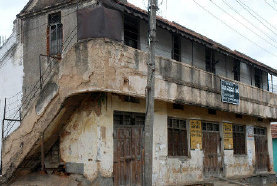It’s not very often that you read something positive about politicians. And by ‘positive’ I mean ‘doing things they’re elected to do’. (Isn’t that sad? That we only get to read that they’re doing their job, not that they’re doing much more?)
So when I read this news item in The Hindu today I was happy. I’ve been following the Lok Satta’s survey of government schools, wondering if it would be just another report that tells us what we all know anyway. And I was pleasantly surprised to read that they’ve transformed a government school in Kukatpally (the constituency that JP represents), giving it amenities like drinking water, toilets, and a clean, white-washed building. At a cost of Rs. 60,000, over a period of a fortnight, through donations collected by the party. Which makes you wonder: sixty grand plus two weeks per government school. Is this too much to ask of the government? Isn’t this the kind of thing one wants to see done with tax-payer money?
But of course the government has other priorities — like sponsoring Varuna Yagams to propitiate the rain-god. (In the process, the TTD not only gets free publicity, it also gets paid!) And once the rains do come down, thanks to the monsoon, the government will of course claim credit and tell us: “See! We will bring the heavens down for you!”
What’s a government school by comparison? Pshaw! Insignificant stuff.
But I’m being foolish. Is education even on the agenda for the government? If it were, Kapil Sibal would be tackling the real problems plaguing education, like the wildly diverging standards of schools even within a single state, not just across the country, and the commercialization of (and thereby restricted access to) education. Problems which can only be exacerbated by making school-leaving examinations optional and FDI the focus of reforms.
Education is all set to become THE cash cow for the next five years. Cui bono? one asks (not) in utter despair.
Tokenism. We’ve become so accustomed to it, that we’ve come to expect it as the norm. Not just tokenism, but symbolism as well. Like Mayawati’s statue-unveiling spree? So much is being made out of it — that it’s a symbolic act of claiming public space for the unrepresented, that its purpose is not self-glorification, but self-respect for Dalits.
And people actually buy this. That self-respect comes not from having decent education, healthcare, sanitation, and employment, but from statues! That all of these can be deferred, achieved at a later date once self-respect has been achieved.
Yes, Mayawati is an awe-inspiring phenomenon; a Dalit woman serving as Chief Minister of the country’s most populous state for four terms is nothing short of a miracle. And yes, the media and opposition parties’ criticism is unfair, given the legacy of the upper caste parties as far as statues and memorials go. So Mayawati’s statues become symbolic attacks on this upper caste legacy.
Again, cui bono? The people whom upper caste parties represent have the means, the resources, the abilities to run their lives without government help. The people whom Mayawati represents do not. Give them self-respect? Give them (her famed birthday) cake?
As S. Anand puts it in this wonderfully balanced piece on the issue:
“While symbolic politics have played a significant part in democratization, today this seems a convenient motive for the Dalit middle class leadership to sweep issues of class under the carpet and to talk exclusively of issues of dignity.”
Education is the only thing that can dignify the lives of Dalits. And to think that Mayawati had the opportunity given to her to make this change happen, not once but four times . . . tragic.
